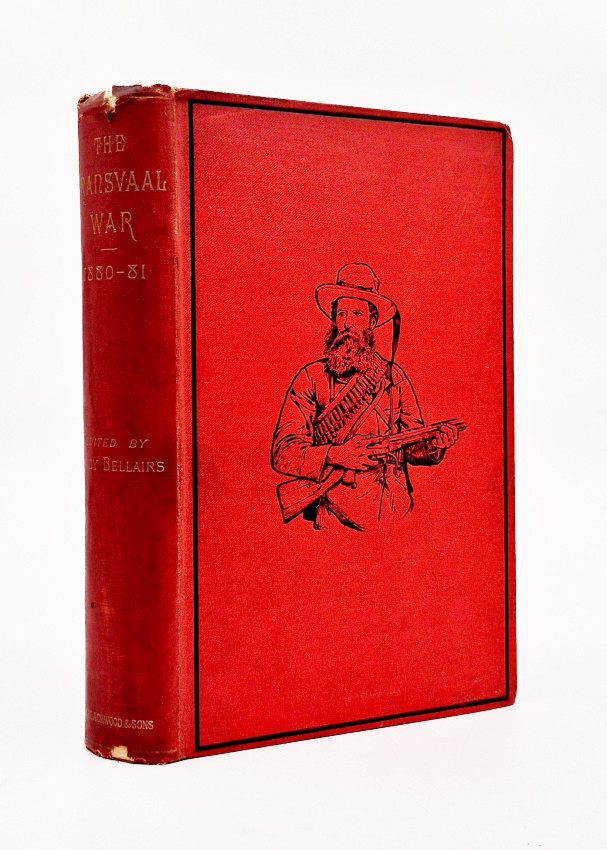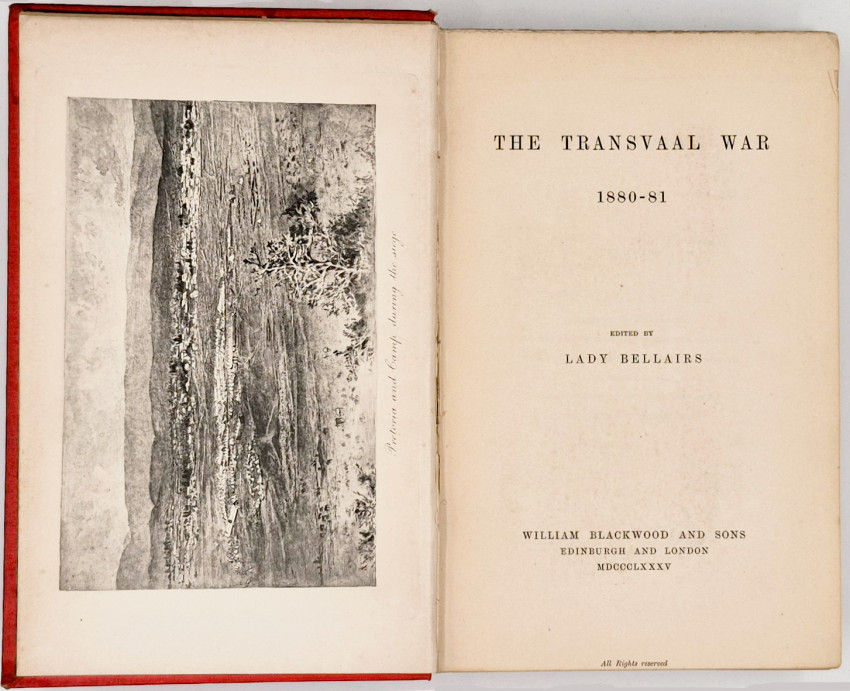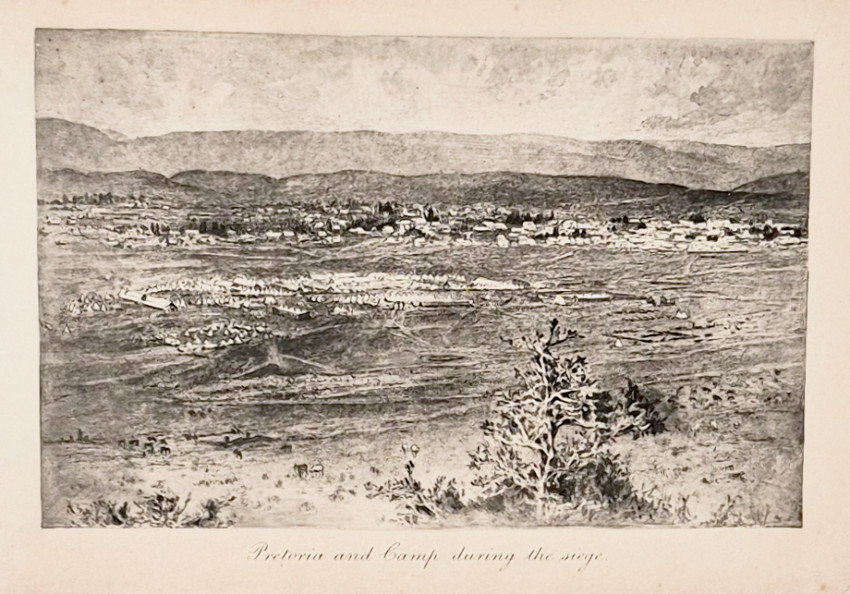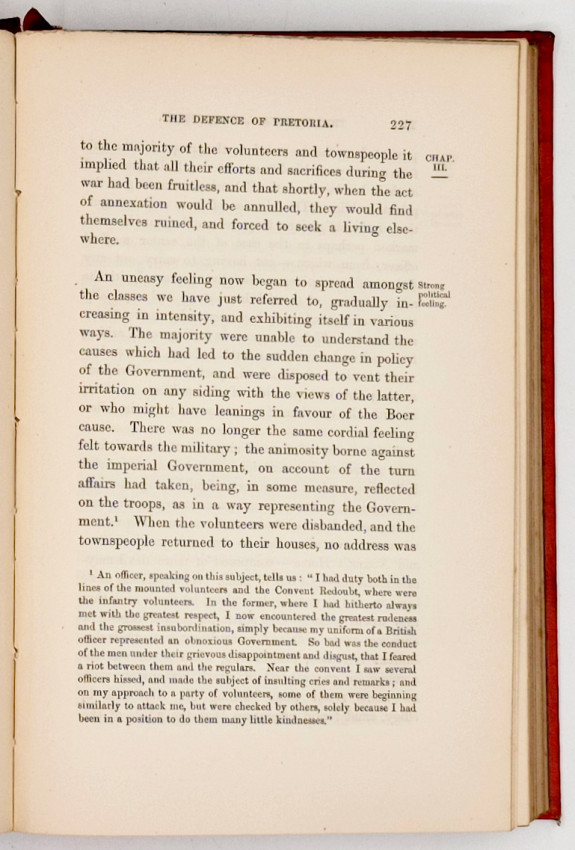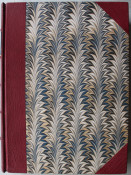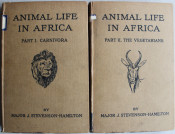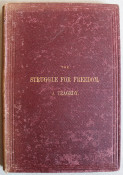First Edition: 500 and 24 pages of publisher's catalogue, frontispiece, map, red cloth with a vignette of a Boer soldier on the upper cover and gilt titling on the spine, top and bottom of the spine frayed, original black endpapers, a very good copy.
Mendelssohn (Sidney) South African Bibliography volume 1, page 113, 'It is admitted that the accounts given, as well as “the opinions expressed, are mainly based upon official documents." The author de-scribes the contest as "a most unnecessary war," and states that " too great eagerness to carry out a federation scheme defeated its own object, leading as it did to a too hasty annexation of the Transvaal — the primary cause of the Zulu War, and bringing in its train the Boer rebellion." It is pointed out that although a Liberal Government had replaced the Conservative administration under which the Transvaal was annexed, the promises of self-government for the country, made by Sir T. Shepstone, had not been kept, and that when the Cape Parliament rejected the proposal for a conference on the subject of Confederation, it was resolved to further withhold self-government from the Transvaal Boers in order to induce them to throw in their lot with the Cape Colony. The substitution of Sir Owen Lanyon for Sir T. Shepstone seems to have been injudicious as well as unfortunate. Lanyon was of swarthy complexion, and the Boers thought he was of black descent and disdained to be ruled by him: he was a British soldier (" rooibatje "), and as such an object of detestation to these people; unlike Shepstone, he did not speak or understand their language, although he did his best to conciliate them in his own way. Some time before hostilities broke out, Colonel Bellairs had drawn attention to the faulty disposition of the troops in the country, and had protested, but vainly, against the reduction in their numbers ; and it is asserted that the withdrawal of the " King's Dragoon Guards " partook of something of the nature of a gambler's stake on chance, " to effect an economy of a few thousands." The British authorities appeared to have been permeated with the idea “that the Boers were wanting in pluck and would therefore not become dangerous." The volume gives an account of " the origin of the Boer revolt," and describes " the Bronkhorst Spruit disaster," "the defence of Pretoria," and the sieges of Potchefstroom, Rustenburg, Marabastadt, Leydenburg, Standerton, and Wakkerstroom; and there are chapters on "the Natal Relief Column," and "armistice and peace." The account of the siege and defence of Pretoria is very interesting, and it is to be remarked that many of the Boers are mentioned as fighting on the British side, among other well-known names being those of Mr. Justice Kotze and Chief Justice De Wet, and many quotations are given from the newspaper published during the siege, entitled News of the Camp (see Duval, Charles). Among the besieged were the wives of Dr. Jorissen, State Attorney, and Mr. Bok, State Secretary of the Boer Government, these ladies being accommodated in the Jail Laager. In the Appendix there is an extract from the report of Captain Raff, C.M.G., dated Potchefstroom, November 28, 1880, which gives details of a meeting between George Hudson, Colonial Secretary of the Transvaal, and Kruger, Cronje, Bodenstein, Fouche, and other prominent Boers, at which Kruger and Cronje condemned the action of the English Government with reference to pressing Bezuidenhout's case during the prevailing discontent, and stated that the people were exasperated by such ill-timed severity, and that they washed their hands of all responsibility.'
See also: Major-General Sir William Bellairs (https://en.wikipedia.org/wiki/William_Bellairs)
- Overall Condition: A very good copy
- Size: 8vo (220 x 145 mm)

